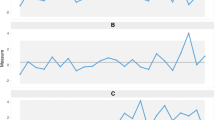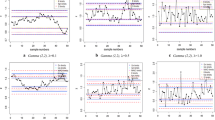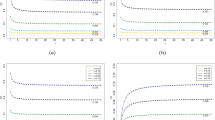Abstract
This study explored a new nonparametric analytical method for identifying heterogeneous segments in time-series data for data-abundant processes. A sample entropy (SampEn) algorithm often used in signal processing and information theory can also be used in a time series or a signal stream, but the original SampEn is only capable of quantifying process variation changes. The proposed algorithm, the adjusted sample entropy (AdSEn), is capable of identifying process mean shifts, variance changes, or mixture of both. A simulation study showed that the proposed method is capable of identifying heterogeneous segments in a time series. Once segments of change points are identified, any existing change-point algorithms can be used to precisely identify exact locations of potential change points. The proposed method is especially applicable for long time series with many change points. Properties of the proposed AdSEn are provided to demonstrate the algorithm’s multi-scale capability. A table of critical values is also provided to help users accurately interpret entropy results.












Similar content being viewed by others
Abbreviations
- SampEn:
-
Sample entropy
- AdSEn:
-
Adjusted sample entropy
- i.i.d.:
-
Independent and identically distributed
- HDS:
-
Historical data series
- CUSUM:
-
Cumulative sum
- EWMA:
-
Exponential moving average
- ApEn:
-
Approximate entropy
References
Kotz S, Johnson NL, Hubele NF, Spiring F, Cheng S, Yeung A, Leung B, Rodriguez RN, Bothe D, Rlu M-W (2002) Process capability indices: a review, 1992–2000. Discussions. J Qual Technol 34(1):2–53
Montgomery DC (2009) Statistical quality control, vol 7. Wiley, New York
Sullivan JH (2002) Detection of multiple change points from clustering individual observations. J Qual Technol 34(4):371
Dupuis D, Sun Y, Wang HJ (2015) Detecting change-points in extremes. Stat Interface 8(1):19
Jarušková D (2015) Detecting non-simultaneous changes in means of vectors. Test 24(4):681–700
Brodsky B, Darkhovsky B (1993) Nonparametric methods in change point problems. Kluwer, Dordrecht
Page E (1955) A test for a change in a parameter occurring at an unknown point. Biometrika 42(3/4):523–527
Hinkley DV (1971) Inference about the change-point from cumulative sum tests. Biometrika 58(3):509–523
Bhattacharya P, Frierson D Jr (1981) A nonparametric control chart for detecting small disorders. Ann Stat 9(3):544–554
Darkhovsky B, Brodsky B (1987) Nonparametric method of the quickiest detection of a change in mean of a random sequence. Theory Probab Appl 32(4):703–711
Pettitt A (1980) A simple cumulative sum type statistic for the change-point problem with zero-one observations. Biometrika 67:79–84
Deshayes J, Picard D (1985) Off-line statistical analysis of change-point models using non parametric and likelihood methods. In: Basseville M (ed) Detection of abrupt changes in signals and dynamical systems. Springer, Berlin, pp 103–168
Yin Y (1988) Detection of the number, locations and magnitudes of jumps. Commun Stat Stoch Models 4(3):445–455
Xie Y, Huang J, Willett R (2013) Change-point detection for high-dimensional time series with missing data. IEEE J Sel Top Signal Process 7(1):12–27
Liu S, Yamada M, Collier N, Sugiyama M (2013) Change-point detection in time-series data by relative density-ratio estimation. Neural Netw 43:72–83
Shannon C (1948) A mathematical theory of communication. Bell Syst Tech J 27: 379–423 and 623–656. (MathSciNet): MR10, 133e
Kolmogorov AN (1998) On tables of random numbers. Theor Comput Sci 207(2):387–395
Pincus SM (1991) Approximate entropy as a measure of system complexity. Proc Natl Acad Sci 88(6):2297–2301
Pincus SM, Goldberger AL (1994) Physiological time-series analysis: what does regularity quantify? Am J Physiol Heart Circ Physiol 266(4):H1643–H1656
Shardt YA, Huang B (2013) Statistical properties of signal entropy for use in detecting changes in time series data. J Chemom 27(11):394–405
Liu H, Han M (2014) A fault diagnosis method based on local mean decomposition and multi-scale entropy for roller bearings. Mech Mach Theory 75:67–78
Zheng Y, Sun C, Li J, Yang Q, Chen W (2011) Entropy-based bagging for fault prediction of transformers using oil-dissolved gas data. Energies 4(8):1138–1147
Jha PK, Jha R, Datt R, Guha SK (2011) Entropy in good manufacturing system: tool for quality assurance. Eur Eur J Oper Res 211(3):658–665
Zhang Z (2012) Manufacturing complexity and its measurement based on entropy models. Int J Adv Manuf Technol 62(9–12):867–873
Nair SS, Joseph KP (2014) Chaotic analysis of the electroretinographic signal for diagnosis. BioMed Res Int. https://doi.org/10.1155/2014/503920
Richman JS, Moorman JR (2000) Physiological time-series analysis using approximate entropy and sample entropy. Am J Physiol Heart Circ Physiol 278(6):H2039–H2049
Lake DE, Richman JS, Griffin MP, Moorman JR (2002) Sample entropy analysis of neonatal heart rate variability. Am J Physiol Regul Integr Comp Physiol 283(3):R789–R797
Grassberger P, Procaccia I (1983) Estimation of the Kolmogorov entropy from a chaotic signal. Phys Lett A 28(4):2591
Grassberger P (1988) Finite sample corrections to entropy and dimension estimates. Phys Lett A 128(6–7):369–373
Borchers HW (2014) Package “pracma”. (1.7.3). Obtained from: https://www.rdocumentation.org/packages/pracma/versions/1.9.9. Accessed 6 June 2018
Lake DE, Moorman JR (2010) Accurate estimation of entropy in very short physiological time series: the problem of atrial fibrillation detection in implanted ventricular devices. Am J Physiol Heart Circ Physiol Ajpheart 00561:2010
Tano I, Vännman K (2013) A multivariate process capability index based on the first principal component only. Qual Reliab Eng Int 29(7):987–1003
Xie H-B, Guo J-Y, Zheng Y-P (2010) Using the modified sample entropy to detect determinism. Phys Lett A 374(38):3926–3931
Kong D-R, Xie H-B (2011) Use of modified sample entropy measurement to classify ventricular tachycardia and fibrillation. Measurement 44(4):653–662
Acknowledgements
This work was based on Mr. Zhang’s thesis as partial fulfillment of his MS degree in the Department of Industrial and Manufacturing Systems Engineering at Kansas State University, Manhattan, KS. Mr. Malmir’s support was based on the Biomass Research and Development Initiative Program with Grant No. 2012-10006-20230 from the US Department of Agriculture National Institute of Food and Agriculture. Dr. Kong was supported by the Fundamental Research Funds for the Central Universities projects under Grant Nos. 7214487602 and 72134876 and co-supported by Shaanxi Provincial scientific and technological research projects under Grant No. DF0102130401. He was a research visiting scholar to the IMSE department at Kansas State University.
Author information
Authors and Affiliations
Corresponding author
Ethics declarations
Conflict of interest
The authors have no conflict of interest to declare.
Rights and permissions
About this article
Cite this article
Chang, S.I., Zhang, Z., Koppel, S. et al. Retrospective analysis for phase I statistical process control and process capability study using revised sample entropy. Neural Comput & Applic 31, 7415–7428 (2019). https://doi.org/10.1007/s00521-018-3556-4
Received:
Accepted:
Published:
Issue Date:
DOI: https://doi.org/10.1007/s00521-018-3556-4




